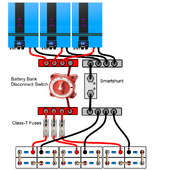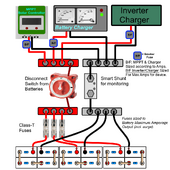Blown284
New Member
If it helps, I have both of the batteries connected to a smart shunt.
Battery #1 (original 200ah with 100a BMS) is currently showing 13.59 and battery #2 with 200a BMW is showing 13.57. Battery #1 voltage is going up faster than battery #2. However, battery #1 has also been charged in the past whereas battery #2 is a new arrival to me and I'm just charging it.
Battery #1 (original 200ah with 100a BMS) is currently showing 13.59 and battery #2 with 200a BMW is showing 13.57. Battery #1 voltage is going up faster than battery #2. However, battery #1 has also been charged in the past whereas battery #2 is a new arrival to me and I'm just charging it.
Ok so I need to move the charger - off of the #1 battery and move it to #2 battery since I guess it's the end of that circuit. Sorry if I've made this confusing --- certainly isn't my intent. I also don't feel like burning my house down LOLcharger + > bus bar + > battery1 +post
...............................................> battery2 +post
charger - > bus bar - > battery1 -post
...............................................> battery2 -post




